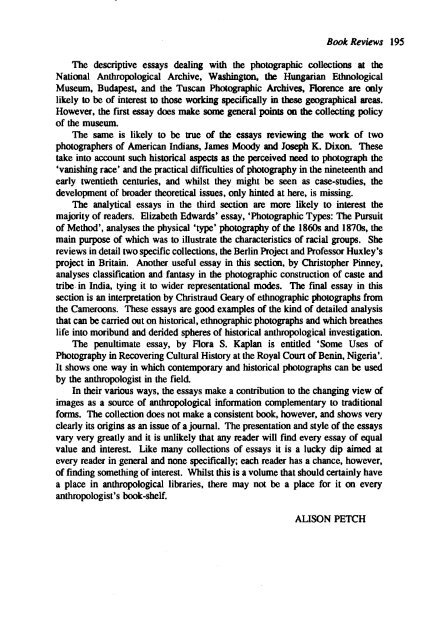1991 No. 1 CONTENTS - Institute of Social and Cultural ...
1991 No. 1 CONTENTS - Institute of Social and Cultural ...
1991 No. 1 CONTENTS - Institute of Social and Cultural ...
Create successful ePaper yourself
Turn your PDF publications into a flip-book with our unique Google optimized e-Paper software.
Book Reviews 195<br />
The descriptive essays dealing with the photographic collections at the<br />
National Anthropological Archive, Washington, the Hungarian Ethnological<br />
Museum, Budapest, <strong>and</strong> the Tuscan Photographic Archives, Florence are only<br />
likely to be <strong>of</strong> interest to those working specifically in these geographical areas.<br />
However, the fust essay does make some general points OIl the collecting policy<br />
<strong>of</strong> the museum.<br />
The same is likely to be true <strong>of</strong> the essays reviewing the work <strong>of</strong> two<br />
photographers <strong>of</strong> American Indians, James Moody <strong>and</strong> Joseph K. Dixoo. These<br />
take into account such historical aspects as the perceived need to photograph the<br />
'vanishing race' <strong>and</strong> the practical difficulties <strong>of</strong> photography in the nineteenth <strong>and</strong><br />
early twentieth centuries, <strong>and</strong> whilst they might be seen as case-studies, the<br />
development <strong>of</strong> broader theoretical issues, only hinted at here, is missing.<br />
The analytical essays in the third section are more likely to interest the<br />
majority <strong>of</strong> readers. Elizabeth Edwards' essay, 'Photographic Types: The Pursuit<br />
<strong>of</strong> Method', analyses the physical 'type' photography <strong>of</strong> the 1860s <strong>and</strong> 1870s, the<br />
main purpose <strong>of</strong> which was to illustrate the characteristics <strong>of</strong> racial groups. She<br />
reviews in detail two specific collections, the Berlin Project <strong>and</strong> Pr<strong>of</strong>essor Huxley's<br />
project in Britain. Another useful essay in this section, by Christopher Pinney,<br />
analyses classification <strong>and</strong>· fantasy in the photographic construction <strong>of</strong> caste <strong>and</strong><br />
tribe, in India, tying it to wider representational modes. The fmal essay in this<br />
section is an interpretation by Christraud Geary <strong>of</strong> ethnographic photographs from<br />
the Cameroons. These essays are good examples <strong>of</strong> the kind <strong>of</strong> detailed analysis<br />
that can be carried out on historical, ethnographic photographs <strong>and</strong> which breathes<br />
life into moribund <strong>and</strong> derided spheres <strong>of</strong> historical anthropological investigation.<br />
The penultimate essay, by Flora S. Kaplan is entitled 'Some Uses <strong>of</strong><br />
Photography in Recovering <strong>Cultural</strong> History at the Royal Court <strong>of</strong> Benin, Nigeria'.<br />
It shows one way in which contemporary <strong>and</strong> historical photographs can be used<br />
by the anthropologist in the field<br />
In their various ways, the essays make a contribution to the changing view <strong>of</strong><br />
images as a source <strong>of</strong> anthropological infonnation complementary to traditional<br />
forms. The collection does not make a consistent book, however, <strong>and</strong> shows very<br />
clearly its origins as an issue <strong>of</strong> a journal. The presentation <strong>and</strong> style <strong>of</strong> the essays<br />
vary very greatly <strong>and</strong> it is unlikely that any reader will fmd every essay <strong>of</strong> equal<br />
value <strong>and</strong> interest. Like many collections <strong>of</strong> essays it is a lucky dip aimed at<br />
every reader in general <strong>and</strong> none specifically; each reader has a chance, however,<br />
<strong>of</strong> finding something <strong>of</strong> interest. Whilst this is a volume that should certainly have<br />
a place in anthropological libraries, there may not be a place for it on every<br />
anthropologist's book -shelf.<br />
ALISON PETCH
















